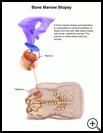
Bone Marrow Biopsy and Aspiration
________________________________________________________________________
KEY POINTS
- A bone marrow biopsy and aspiration is a procedure for taking samples of tissue from the center of a bone for tests.
- A bone marrow biopsy helps diagnose blood disorders.
- Ask your child’s healthcare provider how and when you will get your child’s test results and how to take care of your child at home.
________________________________________________________________________
What is a bone marrow biopsy and aspiration?
A bone marrow biopsy and aspiration is a procedure for taking samples of tissue from the center of a bone for tests. Marrow is the soft, fatty tissue inside hard bone. The marrow is where blood cells are formed.
- White blood cells help fight infection.
- Red blood cells carry oxygen and nutrition to your child’s body.
- Platelets help your child’s blood clot.
Why is this test done?
The test results show whether the various types of blood cells are present in normal amounts and are developing normally. Too many or too few of certain types of cells may indicate specific diseases. A bone marrow biopsy helps diagnose blood disorders. These include:
- Low levels of red blood cells (anemia)
- Low levels of white blood cells or platelets
- Blood cell cancers such as leukemia and some other types of cancer
- Infections
- Side effects of cancer therapy
- Blood clotting problems
How do I prepare my child for this procedure?
- Your child may or may not need to take regular medicines the day of the procedure. Tell the healthcare provider about all medicines and supplements your child takes. Some products may increase the risk of side effects. Ask the healthcare provider if your child needs to avoid taking any medicine or supplements before the procedure.
- Tell the healthcare provider if your child has any food, medicine, or other allergies such as latex.
- Your child’s provider will tell you when your child needs to stop eating and drinking before the procedure. This helps to keep your child from vomiting during the procedure.
- Tell your child’s provider if your child has an infection such as a cold.
- Follow any other instructions your child’s healthcare provider may give you.
- Ask any questions you have before the procedure. You should understand what your child’s provider is going to do. You have the right to make decisions about your child’s healthcare and to give permission for any tests or procedures.
What happens during the procedure?
Your child will be given a local anesthetic to numb the area. Your child may also be given medicine to help relax during the test. Your child may be asleep during the test.
Your child’s provider will make a small cut in the skin over your child’s hipbone or breastbone. A needle will then be passed through the cut and into the bone. Your child may feel pressure when the needle is inserted. Your child’s provider may take 2 samples. Your child may have a few seconds of an uncomfortable, pulling feeling.
The entire procedure usually takes about 10 to 15 minutes.
What happens after the procedure?
Unless your child’s provider tells you otherwise, there are no special steps to take after the procedure. Your child may have some soreness and bruising at the biopsy site for a few days.
Ask your child’s healthcare provider:
- How and when you will get your child’s test results
- How long it will take to recover
- If there are activities your child should avoid and when your child can return to normal activities
- How to take care of your child at home
- What symptoms or problems you should watch for and what to do if your child has them
Make sure you know when you should come back for a checkup. Keep all appointments for provider visits or tests.
What are the risks of this procedure?
Every procedure or treatment has risks. Some possible risks of this procedure include:
- Your child may have problems with anesthesia.
- Your child may have bleeding or pain at the biopsy site.
- The needle may puncture a nearby blood vessel, an organ, or a gland. This could cause it to leak or bleed.
- If the needle crosses a collection of bacteria, it could spread an infection to other areas or to the bloodstream.
Ask your child’s healthcare provider how these risks apply to your child. Be sure to discuss any other questions or concerns that you may have.
Last modified: 2021-12-07
Last reviewed: 2019-10-25

